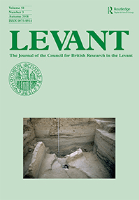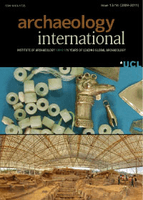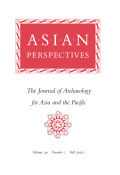
Levant
Scope & Guideline
Exploring the Rich Tapestry of the Levant's Past
Introduction
Aims and Scopes
- Archaeological Research and Methodologies:
The journal emphasizes rigorous archaeological methodologies, including fieldwork, excavation reports, and artifact analyses, to contribute to the understanding of the Levant's ancient cultures. - Interdisciplinary Approaches:
It promotes interdisciplinary research that integrates archaeological findings with historical, anthropological, and environmental studies, facilitating a comprehensive understanding of cultural development. - Cultural Heritage and Preservation:
The journal addresses issues related to cultural heritage management, preservation practices, and the ethical considerations surrounding archaeological research in the Levant. - Socio-Economic Dynamics:
Research often focuses on the socio-economic aspects of ancient societies, exploring trade networks, resource management, and community interactions throughout various historical periods. - Regional Connectivity and Interaction:
The journal highlights themes of connectivity and cultural interaction within the Levant and with neighboring regions, emphasizing the historical significance of exchanges between different cultures.
Trending and Emerging
- Micro-Geoarchaeology:
Recent publications have increasingly adopted micro-geoarchaeological methods to explore socio-economic aspects and environmental changes, indicating a trend towards detailed, localized studies that enhance our understanding of ancient livelihoods. - Cultural Heritage Ethics:
There is a growing focus on ethical considerations in archaeological practice, including discussions on the illicit trafficking of cultural objects and the responsibilities of archaeologists towards heritage preservation. - Digital Archaeology and Big Data:
The integration of digital tools and methodologies, such as remote sensing and data management systems, has become more prevalent, reflecting a shift towards utilizing technology for enhanced archaeological research and heritage management. - Interdisciplinary Collaborations:
Emerging themes highlight the importance of collaborative efforts across disciplines, with studies examining the intersections of archaeology, anthropology, and cultural heritage, fostering a holistic approach to understanding the past. - Social Dimensions of Archaeology:
There is an increasing emphasis on the social aspects of archaeological findings, including community interactions, identity formation, and cultural continuity, which provides a deeper insight into the human experience in the Levant.
Declining or Waning
- Late Antique Studies:
There has been a noticeable decrease in publications focused specifically on Late Antique archaeology, suggesting a shift towards earlier periods of interest or contemporary issues in archaeological research. - Traditional Artifact Typologies:
Research concentrating on traditional artifact typologies has diminished, possibly due to a growing preference for more nuanced analyses that consider broader social, economic, and environmental contexts. - Historical Documentation of Excavations:
The emphasis on documenting excavation methodologies and findings in a purely historical context has waned, as scholars increasingly prioritize interpretative frameworks and interdisciplinary approaches.
Similar Journals

Chinese Archaeology
Fostering Knowledge of China's Archaeological TreasuresChinese Archaeology, published by WALTER DE GRUYTER GMBH, is a leading journal dedicated to the exploration and study of China's rich archaeological heritage. With an ISSN of 2160-5025 and an E-ISSN of 2160-5068, this journal serves as an essential platform for scholars, researchers, and enthusiasts in the field of archaeology, offering a blend of original research articles, reviews, and critical essays that address both contemporary issues and historical narratives. While it currently operates under a conventional access model, making cutting-edge research available to a select audience, it plays a crucial role in advancing knowledge about China's archaeological sites, artifacts, and past civilizations. Given the increasing interest in Eastern archaeology and its significance in a global context, Chinese Archaeology is positioned as a pivotal resource for understanding and interpreting the complexities of China’s historical evolution. Researchers and academics are encouraged to contribute and engage with this vital field of study to foster greater insights and innovations.

African Archaeological Review
Pioneering Research on Africa's Archaeological LandscapeWelcome to the African Archaeological Review, a leading academic journal published by Springer, dedicated to advancing the field of archaeology with a unique focus on the African continent. Since its inception in 1983, this journal has become a pivotal platform for researchers, professionals, and students seeking to explore the complexities of African cultural heritage through empirical studies, theoretical discussions, and methodological innovations. With a commendable Q1 ranking in both Archaeology (Arts and Humanities) and Archaeology categories for 2023, this journal ranks among the top 10% of publications in its field, reflecting its influential contributions to archaeological scholarship. The Scopus ranking places it at #40 out of 413 in Arts and Humanities and #39 out of 354 in Social Sciences, highlighting its esteemed status within academic circles. Although it does not currently offer Open Access options, the journal remains committed to disseminating vital research findings that shape our understanding of Africa's rich archaeological landscape. Join a community dedicated to unraveling past human behaviors and interactions within diverse African environments through the pages of the African Archaeological Review.

Anadolu Arastirmalari-Anatolian Research
Innovating Insights into Archaeology and HistoryAnadolu Arastirmalari-Anatolian Research, published by ISTANBUL UNIVERSITY, is a prominent open-access journal dedicated to the exploration of history, archaeology, and related fields. Since its transition to open access in 2017, the journal has become a vital resource for scholars and practitioners, facilitating the dissemination of innovative research findings. With a strong focus on the intricacies of Anatolian history and archaeology, the journal has earned notable recognition, achieving a Q1 ranking in History and Q2 rankings in both Archaeology and Arts and Humanities categories as of 2023. This positions it among the foremost journals in its field, providing an essential platform for interdisciplinary research and discourse. The journal's impact factor is evidenced by its significant citation metrics and rigorous editorial standards, aiming to contribute meaningfully to scholarly dialogue and knowledge production. Researchers, professionals, and students alike will find this journal indispensable for understanding the rich tapestry of Anatolian culture and heritage.

Slovenska Archeologia
Connecting scholars to the treasures of Slovakia's archaeological landscape.Slovenska Archeologia is a prominent journal published by the Slovak Academy of Sciences, Institute of Archaeology, dedicated to advancing the field of archaeology through rigorous scholarly research and insightful scholarship. With an ISSN of 1335-0102 and an E-ISSN of 2585-9145, this journal has been a vital platform for archaeologists and academics since its inception, converging its insightful publications from the years 2017 to 2023. Awarded a Q2 ranking in the field of archaeology across both arts and humanities categories, it holds a respectable position in the Scopus rankings, recognizing its contributions to the discipline. Based in Slovakia, the journal is an essential resource for professionals, researchers, and students interested in archaeological findings and methodologies. While it does not currently offer Open Access options, its commitment to promoting high-quality research makes it a valuable addition to the academic community.

Archaeology International
Exploring the past to illuminate the future of archaeology.Archaeology International is a prestigious open-access journal dedicated to advancing the field of archaeology since its inception in 1997. Published by UCL PRESS, the journal provides a platform for researchers, professionals, and students to disseminate their findings and share innovative ideas in archaeological studies. It features a rich array of articles that capture current trends, methodologies, and debates within the discipline, fostering a collaborative academic environment. Based in London, England, this journal is committed to accessibility and inclusivity, ensuring that valuable research is available to a global audience without subscription barriers. With a focus on interdisciplinary approaches, Archaeology International serves as an essential resource for those interested in the preservation of cultural heritage, and it actively encourages contributions that explore both past civilizations and contemporary archaeological practices.

JOURNAL OF EGYPTIAN ARCHAEOLOGY
Delving into the Legacy of Ancient CivilizationsJOURNAL OF EGYPTIAN ARCHAEOLOGY is a premier publication dedicated to advancing the study of ancient Egyptian culture, artifacts, and historical contexts. Published by SAGE PUBLICATIONS LTD in the United Kingdom, this journal has been an authoritative source of archaeological scholarship since its inception in 1964. It boasts an impressive reputation, currently holding a Q3 ranking in Archeology and Q2 rankings in both Archeology (arts and humanities) and History for 2023, underlining its importance in its field. With a focus on interdisciplinary research, the journal provides a platform for in-depth analysis and discussion among scholars, researchers, and students alike. The journal is also indexed in Scopus, with notable rankings that reflect its influence and reach within the academic community, especially among arts and humanities disciplines. Although it is not an Open Access publication, the insights offered through its meticulously curated articles are invaluable for anyone looking to deepen their understanding of Egyptology and archaeological practices. For scholars seeking to engage with contemporary discussions in this fascinating field, the JOURNAL OF EGYPTIAN ARCHAEOLOGY serves as an essential resource.

Asian Perspectives-The Journal of Archaeology for Asia and the Pacific
Fostering Dialogue: Insights into Asia and the Pacific's Rich TapestryAsian Perspectives - The Journal of Archaeology for Asia and the Pacific is a prestigious journal published by University of Hawaii Press, focusing on the intricate field of archaeology in Asia and the Pacific. With a rich publication history dating back to 1993, the journal has established itself as a vital platform for disseminating research that illuminates the archaeological heritage and cultural dynamics of this diverse region. Recognized for its scholarly impact, it enjoys a commendable impact factor and ranks in the Q2 category for Anthropology and Archaeology, indicating its significant contribution to these fields. Although it operates on a traditional subscription-based model, the journal is accessible to institutional and individual subscribers worldwide. With an emphasis on interdisciplinary research, Asian Perspectives invites contributions that foster a deeper understanding of historical and contemporary issues through archaeology, making it an invaluable resource for researchers, professionals, and students alike committed to advancing scholarly dialogue in the region. Explore a wealth of innovative studies and insights that continue to shape the understanding of Asia and the Pacific's archaeological narrative.

Bulletin of the American Society of Overseas Research
Bridging gaps in knowledge with innovative research and discourse.Bulletin of the American Society of Overseas Research, published by the University of Chicago Press, serves as a premier platform for scholarly discourse in the fields of archaeology, cultural studies, and history. With its ISSN 2769-3600 and E-ISSN 2769-3589, this journal has swiftly established itself as a key resource for researchers, professionals, and students alike, demonstrating exceptional impact as evidenced by its Q1 rankings in multiple relevant categories for 2023. Notably, it holds the 93rd percentile rank in Arts and Humanities (History) and the 84th percentile in Social Sciences (Cultural Studies), evidencing its respected standing within the academic community. The journal's commitment to advancing knowledge and fostering interdisciplinary dialogue is complemented by its accessible publication from 2022 to 2024, making it an essential read for those engaged in the exploration of global cultural histories and archaeological research.

Lanx-Journal of the Scuola di Specializzazione in Archeologia of the University of Milan
Uncovering the past, enriching the future.Lanx-Journal of the Scuola di Specializzazione in Archeologia of the University of Milan, published by Milano University Press, is a distinguished platform dedicated to the field of archaeology. Committed to advancing archaeological research and scholarship, this Open Access journal has been available to the global academic community since 2008, facilitating easy dissemination of innovative ideas and findings. With a strong emphasis on promoting interdisciplinary dialogue, the journal covers a wide range of topics from classical archaeology to contemporary practices, making it an invaluable resource for researchers, professionals, and students in the field. Situated in the historic city of Milan, it aims to contribute to the preservation and understanding of cultural heritage through rigorous academic inquiry and collaboration.

Ancient Asia-Journal of the Society of South Asian Archaeology
Connecting Scholars to the Wonders of Ancient AsiaAncient Asia - Journal of the Society of South Asian Archaeology, published by ARF India, stands as a pivotal resource for the exploration and dissemination of archaeological research focused on the rich history and culture of South Asia. Since its inception as an Open Access journal in 2006, it has become an essential platform for scholars and enthusiasts alike, boasting an impressive range of quartile rankings across multiple disciplines, including Anthropology, Archaeology, History, and Visual Arts. With expansion into various indexed categories and consistent dissemination of impactful research common to this highly diverse field, Ancient Asia aims to foster interdisciplinary dialogue, facilitate collaboration among researchers, and enhance the global understanding of ancient civilizations within the region. By embracing an inclusive access model, the journal encourages wide readership and engagement, positioning itself as a key player for students, professionals, and academics interested in delving into the archaeological marvels of South Asia.